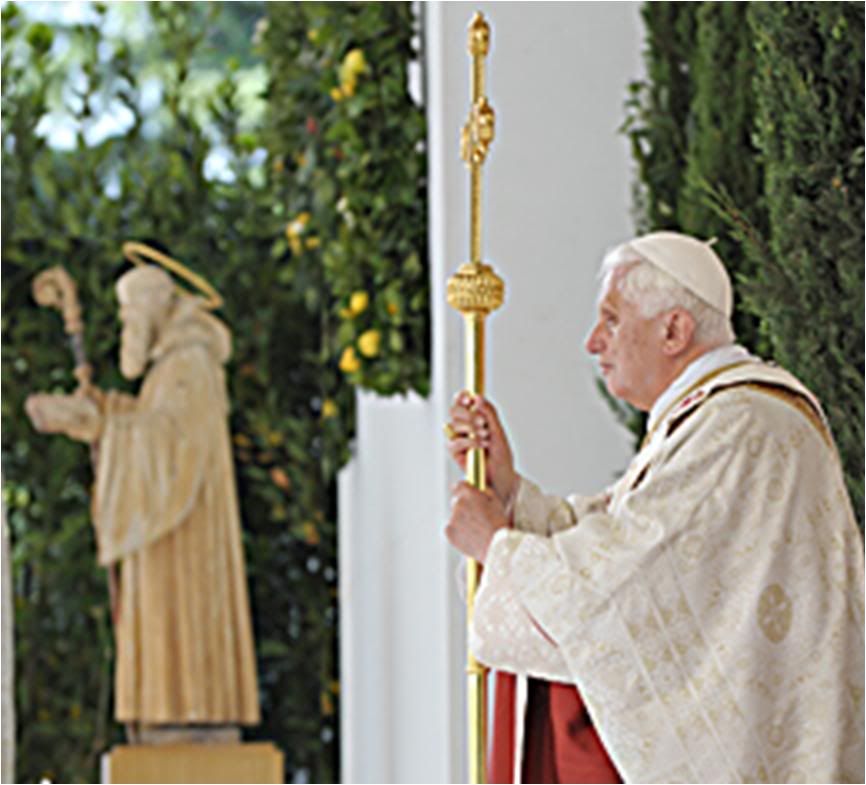 Benedict's Europe:
Benedict's Europe:
Benedict XVI on St. Benedict
Editorial
by Mario Mauro
Vice President, Parliament of Europe, Strasbourg
Translated from

May 25, 2009

Benedict speaks about Benedict.
Four years after his famous 'Subiaco lecture' - when the then Cardinal Ratzinger presented his lectio magitralis on Europe - the Holy Father spoke again yssterday of St. Benedict of Norcia, exemplary figure and Patron Saint of Europe.
In the Abbey of Montecassino, the Pope cirted the symbols of the other Benedict - father of monasticism and proponent of evangelization on our continent - that could ideally represent today the bulwark to which our bimillennial tradition is anchored.
'Ora et labora', pray and work, the Benedictines said, and continue to say. And on this ocncept, the Pope wove a message that touches on the most relevant issues today.
Not a leab back to the past, but a lucid reflection on what is happening today. He expressed his solidarity with those who more than anyone else are paying the price imposed by the current financial crisis: those whose jobs are at risk, those who are already unemployed or have lost jobs,\, and the young people who cannot find work.
He called on responsible persons in government and in the private sector to "create new jobs and safeguard the family, which is strongly udnermined at the very roots of the institution".
Europe can find strategies to resolve the jobs emergency only if it is able to acknowledge its roots, because to create new job possibilities and overcome the present context of crisis, one must first of all fight against all forms of selfishness and seek to protect all families and young people.
St. Benedict, with a Rule made up of work, culture and prayer, contributed to bring Europe out of a period of profound crisis. The Pope has brought to our attention that this is a valid instance for dusting out a simple but effective strategy: to look at our roots and put together all the strength that we can in the same effort so that no one remains behind.
[Ummmm... that's one of those well-meaning political statements that actually say nothing concrete.]
Human dignity indeed comes above all. It is for that dignity - that precisely in our continent has been trampled upon millions of times by the atrocities of ideologies - that institutions have been ready to fight for, somehow never getting the better but rather becoming their guarantors.
It is for this reason, in the memory of all the lives that wars have taken, that the Pope visited the Polish military cemetery in Montecassino, remembering all those who have fallen, from all nations and in all conflicts.
And what does all this have to do with Europe, its institutions and its citizens? Cannot faithfulness and acknowledgment of Christian roots contribute to building a Europe that is unified and fraternally solid in the search for justice and peace?
Perhaps, for those of us who have become accustomed to live in a climate devoid of civil or inter-cultural conflicts, the word 'peace' has acquired a meaning that we take for granted.
But there is a risk. If Europe is not capable of a historical memory that allows it to keep its cultural and religious tradition alive, then it cannot have a future. Shortsightedness never brings anyone far.
Europe has been truly herself and truly great in creating forms of authemtic civilization and progress for people on the universal level, only at those times when it has transmitted the constitutive values that come from the Christian faith after they had become part of the people's patrimony of culture and identity.
Unfortunately, recent history reminds us that institutions are not always capable of recognizing the progress they have made. And it is strange that Europe rejects any reference to its roots, whereas the United States, for exmaple, has never had a problem with relating to God.
Europe was born Christian and only to the degree that it remains Christian can it think of conserving its own idealism and its own original contribution to contemporary civilization.
To udnerstand this more profoundly, one must go back to the fourth century when, during the grave crisis of the Roman Empire, the Church started to develop as a new historical, cultural and political entity to reckon with.
Montecassino Abbey, which has been destroyed four times, and four times reconstructed, is the symbol of this Europe which, although it has been undermined several times at its very foundation, is still on its feet. It has survived wars, it has seen destruction, many times it has been brought to its knees, but today it is still firm and capable of assuring us and our children another 60 years of peace. It is for this reason that we should defend her in memory of St. Benedict.
The visit of Benedict XVI on the eve of an important accpintment that will involve the citizens of the 27 member states of the European Union should impel us to contineu along the path taken by the fathers of oru continent and to strive so that our young people above all may be guaranteed a future of peace and development.